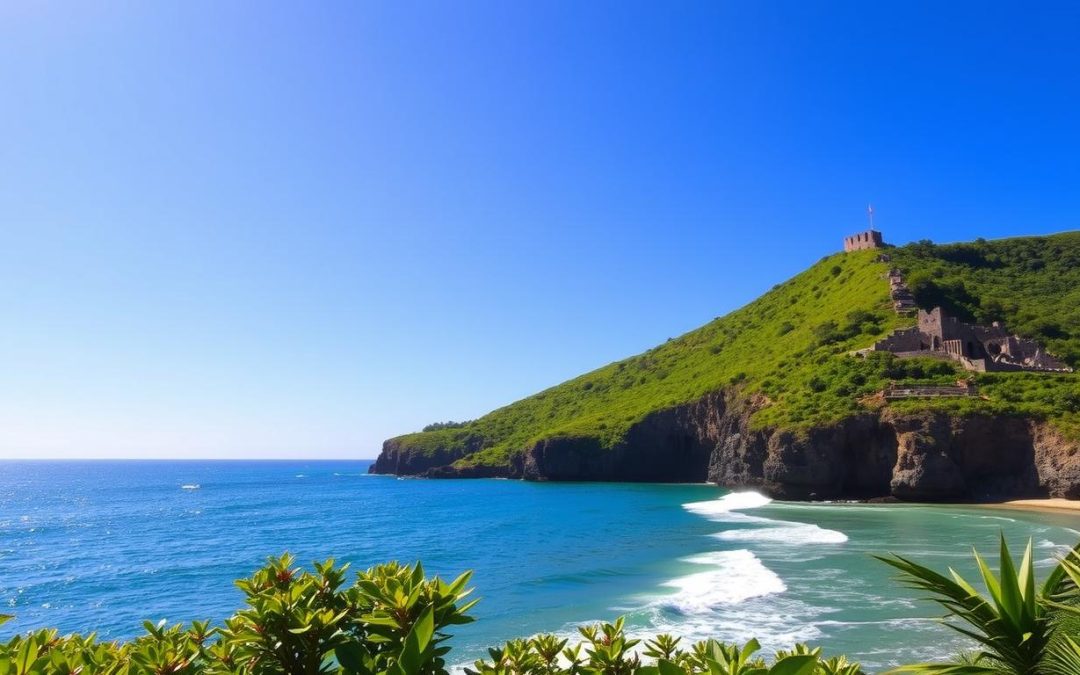Have you ever wondered where history comes alive in every stone and landscape? Corregidor Island in the Philippines is a place where history meets life. It’s a story of bravery and the deep tales of World War II that draw visitors from all over.
Located at the entrance of Manila Bay, Corregidor Island is more than just a military base. It’s a place where history comes alive. This small island, only 5 square kilometers, was the last defense of Philippine-American forces in 1942.
Visiting Corregidor Island is an adventure that takes you deep into Philippine history. It’s perfect for anyone who loves history, adventure, or culture. This place has something special for every traveler.
Key Takeaways
- Corregidor Island is a historic site with profound World War II significance
- Daily tours typically last 9 hours, starting at 7 AM
- Tour packages range from PhP 2,250 on weekdays to PhP 2,449 on weekends
- The island offers multiple historical landmarks and outdoor activities
- Visitors can explore military ruins, memorials, and scenic landscapes
Introduction to Corregidor Island: A Historical Paradise
Corregidor Island is in the heart of Manila Bay. It’s a symbol of strength and importance. This small island fascinates those who want to learn about the Philippines’ military history.
Corregidor Island is a peek into the past. It shows off Spanish landmarks and World War II memories. These stories touch the hearts of visitors from all over.
Location and Geography
Corregidor Island is at the mouth of Manila Bay. It’s 5.49 square kilometers big and 620 feet high. Its location made it a key spot for defense through history.
- Distance from Metro Manila: 48 kilometers
- Distance from Bataan peninsula: 5 kilometers
- Terrain: Rocky, with significant military fortifications
Historical Significance
During World War II, Corregidor Island was called “The Rock.” It was crucial in defending Manila. The island saw fierce battles that changed Pacific warfare.
“Corregidor is more than an island; it’s a living museum of courage and sacrifice.” – Military History Expert
Best Time to Visit
The Philippines has two main seasons. Knowing these can help plan your visit to this historical site.
| Season | Months | Travel Considerations |
|---|---|---|
| Dry Season | November to May | Ideal for exploring outdoor historical sites |
| Rainy Season | June to October | Less crowded, potential weather limitations |
March, April, and May are the warmest months to visit. Day tours cost around PHP 1,000 (USD 20). This makes it easy for history lovers to explore.
How to Get to Corregidor Island
Planning your trip to Corregidor Island needs careful thought. Sun Cruises is your main way to get there. The journey starts with a ferry from Manila.
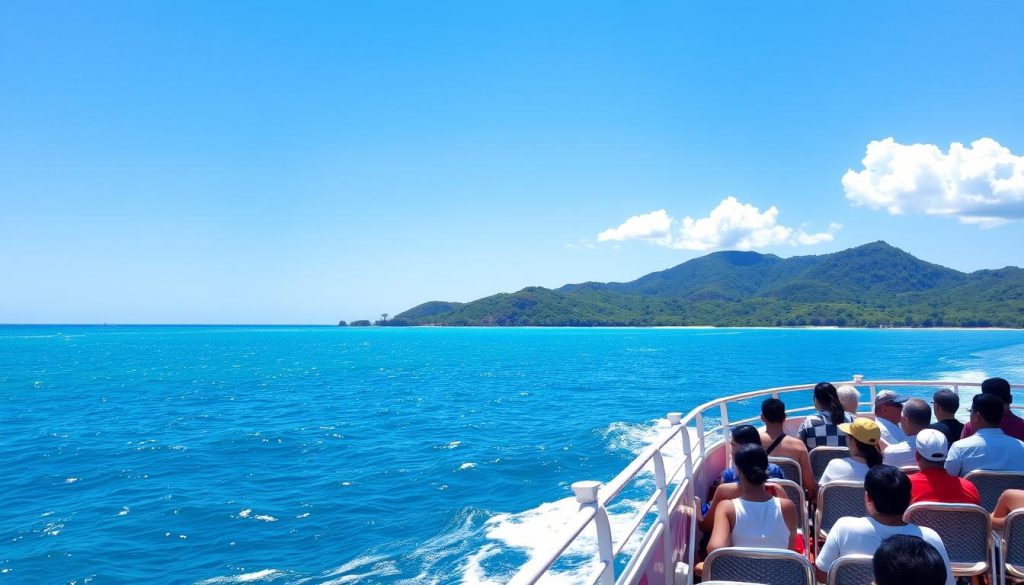
- Ferry leaves at 06:00 AM
- Return trip is at 16:30 PM
- Tour costs 4,500 PHP (about US$80)
The tour package includes:
- Round-trip boat rides
- Entrance fees
- Buffet lunch
- A guided tour of the island
“Exploring Corregidor is like walking through a living museum of Philippine military history.”
If you want a unique experience, consider a private boat charter. It offers flexibility and a closer look at the island’s history.
| Transportation Option | Cost | Inclusions |
|---|---|---|
| Sun Cruises Group Tour | 4,500 PHP | Ferry, Guide, Lunch, Entrance |
| Private Boat Charter | Varies | Customized Itinerary, Flexible Timing |
To make your trip smooth, book your tour early. Corregidor’s spot in Manila Bay makes it a top spot for history buffs and adventure seekers.
Essential Travel Tips and Planning Guide
Getting ready for Corregidor Island needs careful planning and the right stuff. This guide will help you tackle the island’s terrain and enjoy your historical journey.
What to Pack for Your Island Expedition
When packing for Corregidor Island, think about comfort and what you need. The weather is important, especially for hiking and visiting historical spots.
- Lightweight, breathable clothing
- Sturdy walking shoes for hiking trails
- Wide-brimmed hat and sunglasses
- High-SPF sunscreen
- Refillable water bottle
- Light rain jacket
- Camera for capturing memories
Accommodation Options
Most people visit for the day, but Corregidor has a few places to stay overnight. The Sun Cruise Resort is the main spot for longer stays.
| Accommodation Type | Duration | Cost Range |
|---|---|---|
| Day Tour | 9 hours | $50-$75 |
| Overnight Stay | 1-2 nights | $100-$150 |
Tour Packages Available
Many tour operators have packages to see Corregidor’s history and trails. You can choose from historical walks, sunset tours, or photography trips.
“Exploring Corregidor is like walking through a living museum of Philippine and World War II history.” – Local Tour Guide
Pro tip: Book your tour early, especially when it’s busy. Tours usually include transport from Manila, guides, and lunch.
Exploring the Mile-Long Barracks and Military Ruins
Corregidor Island is home to the Mile-Long Barracks, a symbol of its military past. These barracks are about 1,520 feet long, not a full mile. Built from 1908 to 1922, they once housed thousands of soldiers during World War II.
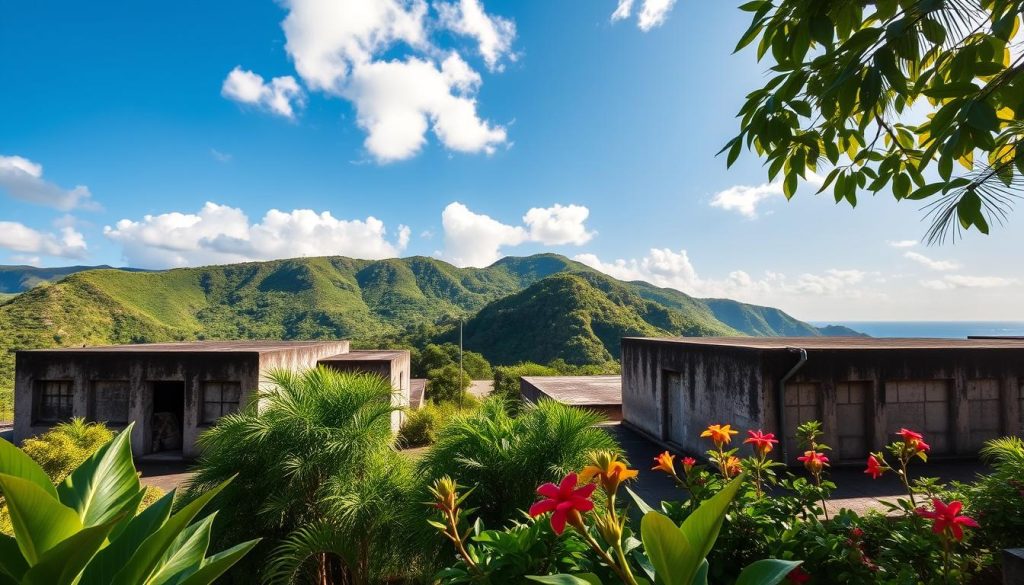
The barracks were built to hold many soldiers. The Topside Mile-Long Barracks could house up to 4,000 troops. During the Japanese invasion, these buildings saw a lot of fighting and were badly damaged.
Key Features of the Mile-Long Barracks
- Located in the Topside area of Corregidor Island
- Constructed during US military development (1908-1922)
- Housed Filipino and American military personnel
- Experienced heavy shelling during World War II
Exploring the ruins shows how strong these buildings were. The Mile-Long Barracks now remind us of the island’s importance and the bravery of its defenders.
“These walls have witnessed the courage of thousands who defended freedom during one of history’s most challenging periods.” – Military Historian
Historical Significance
| Period | Military Significance |
|---|---|
| 1908-1922 | US Military Construction |
| December 1941 | Japanese Bombing |
| World War II | Critical Defense Position |
Visiting the Mile-Long Barracks is a deep dive into history. These ruins give us a unique look into military strategy and human experiences during a difficult time. They are a must-see on Corregidor Island.
Corregidor Island, Philippines: Best Things to Do – Top Picks
Explore Corregidor Island, where history meets nature. It’s perfect for history buffs and adventure lovers. You’ll find unforgettable experiences that make your trip special.
Historical Sites and Landmarks
Don’t miss the island’s famous historical sites. The Mile-Long Barracks, though small, is a big reminder of the island’s past. Key spots include:
- Pacific War Memorial Complex
- Battery Way
- Malinta Tunnel
- Filipino Heroes Memorial
Outdoor Activities
Get ready for outdoor fun. Hike through palm hills for amazing views. Enjoy:
- Guided historical walking tours
- Photography expeditions
- Exploring military installations
- Scenic island trekking
Photography Spots
Photography lovers will find Corregidor Island amazing. Capture stunning views and history. Top spots include:
| Location | Best Time to Photograph |
|---|---|
| Pacific War Memorial | Early morning |
| Malinta Tunnel Entrance | Late afternoon |
| Battery Hearn | Golden hour |
“Corregidor Island offers a unique blend of historical significance and natural beauty that captivates every visitor.” – Local Tour Guide
Pro tip: Take the Sun Cruises day tour for PhP2250 on weekdays. It’s a 9-hour journey. You’ll dive into the island’s history and beauty.
The Malinta Tunnel Experience
Step into the heart of Corregidor’s most profound historical landmark – the Malinta Tunnel. This underground complex is a testament to wartime resilience. It offers visitors a powerful glimpse into the island’s dramatic past. Built between 1922 and 1932, it served as a critical shelter and headquarters during World War II.
The Malinta Tunnel’s story is both haunting and inspiring. During the intense battle of Corregidor, this underground refuge witnessed extraordinary events. Some startling facts about the tunnel include:
- Initially designed as a 1,000-bed hospital
- Constructed using expired TNT and Japanese cement
- Survived massive bombardments during World War II
- Witnessed over 3,000 Japanese soldiers committing mass suicide in 1945
Today, the Malinta Tunnel offers a unique Lights and Sound show. This 30-minute experience costs about 2,500 pesos. It provides visitors with an unforgettable journey through time.
“The Malinta Tunnel represents more than just a military structure – it’s a powerful narrative of human endurance and sacrifice.” – Local Historian
| Tunnel Characteristic | Details |
|---|---|
| Construction Period | 1922-1932 |
| Original Purpose | Military Hospital and Headquarters |
| Show Duration | 30 minutes |
| Ticket Price | 2,500 pesos |
When visiting the Malinta Tunnel, prepare for a deeply moving experience. It connects you directly with the island’s rich military history. Wear comfortable walking shoes, bring a light jacket, and be ready to be transported back in time.
Pacific War Memorial Complex and Museum
Corregidor Island is a deep dive into military history at the Pacific War Memorial Complex. This site honors the brave soldiers of World War II. It’s a moving tribute to their sacrifice and courage.
Memorial Dome
The memorial dome is the heart of the complex. Built in 1968 for $3 million, it symbolizes unity and remembrance. Its design creates a somber mood, perfect for reflecting on the Pacific War’s significance.
Museum Collections
Inside the Pacific War museum, you’ll see a vast collection of artifacts. These tell the story of the wartime struggles. You’ll find:
- Authentic military photographs
- Preserved military equipment
- Personal items from soldiers
- Detailed historical narratives
Eternal Flame Monument
The Eternal Flame Monument is a symbol of remembrance. It honors the soldiers who defended the island in World War II. The flame represents their enduring spirit of freedom.
“Freedom is never free. It requires constant vigilance and sacrifice.” – Unknown Veteran
| Memorial Complex Details | Information |
|---|---|
| Completion Year | 1968 |
| Construction Cost | $3 million |
| Key Features | Memorial Dome, Museum, Eternal Flame |
Visiting the Pacific War Memorial Complex is an immersive historical experience. You’ll learn about the island’s role in World War II. And you’ll honor the heroes who fought for freedom.
Beaches and Natural Attractions
Corregidor Island is more than just a historical site. It’s a treasure trove of natural wonders. The island’s stunning coastlines will amaze anyone who loves nature and snorkeling.
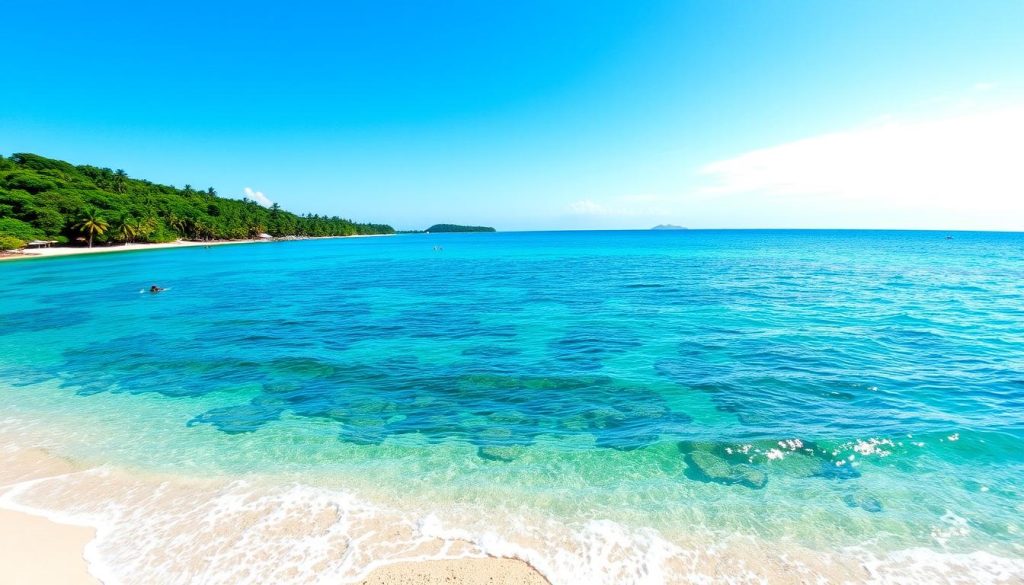
Exploring Corregidor reveals a unique marine world. You’ll find secluded beaches and perfect spots for snorkeling. Despite its small size, the island offers amazing opportunities for underwater adventures and beach relaxation.
- Discover hidden coves with crystal-clear waters
- Explore unique marine ecosystems
- Experience pristine snorkeling spots around the island
- Enjoy scenic coastal landscapes
Snorkeling around Corregidor takes you into a vibrant underwater world. The island’s location in Manila Bay creates special marine habitats. You’ll see colorful coral and tropical fish everywhere.
“Corregidor’s beaches are not just scenic—they’re living memories of the island’s rich ecological heritage.”
| Beach Location | Snorkeling Difficulty | Marine Life Diversity |
|---|---|---|
| North Beach | Beginner | Moderate |
| Bottomside Beach | Intermediate | High |
| South Beach | Advanced | Extensive |
Plan your snorkeling trip with the right gear and follow local rules. The island’s marine life is delicate. Always respect the sea and leave nothing behind.
Japanese Garden of Peace and Filipino Heroes Memorial
Corregidor Island offers deep insights into World War II’s complex history. Two memorial sites tell powerful stories of reconciliation and remembrance.
Japanese Garden of Peace
The Japanese Garden of Peace is a healing symbol. It has a 10-foot-tall stone Buddha statue facing Japan. This statue represents peace and remembrance.
Shinto Shrine
A traditional Shinto shrine is at the garden’s heart. It offers a look into Japanese culture. The shrine honors Japanese soldiers who died in the war, inviting quiet reflection.
Filipino Heroes Memorial
The Filipino Heroes Memorial covers 6,000 square meters. It has 14 detailed murals that tell of Philippine battles from the 15th century to today. Each mural celebrates Filipino bravery and strength.
- Depicts 14 significant battles in Philippine history
- Covers historical periods from 15th century to present day
- Funded to honor Filipino military contributions
“These memorials remind us that understanding history is key to creating a peaceful future.” – Local Historian
Memorial Sculptures
The memorial complex features sculptures that mark historical moments. They show the spirit of Filipino heroism. Visitors can see these artworks that tell of the nation’s fight and victory.
Visiting these sites, you’ll understand Corregidor Island’s complex history better. You’ll see the ongoing stories of reconciliation that still touch us today.
Photography Tips and Best Viewpoints
Corregidor Island is a treasure trove for photographers. It’s a mix of history and nature. Your camera will love the island’s ruins and trails. It’s a perfect place to capture stories of courage and history.
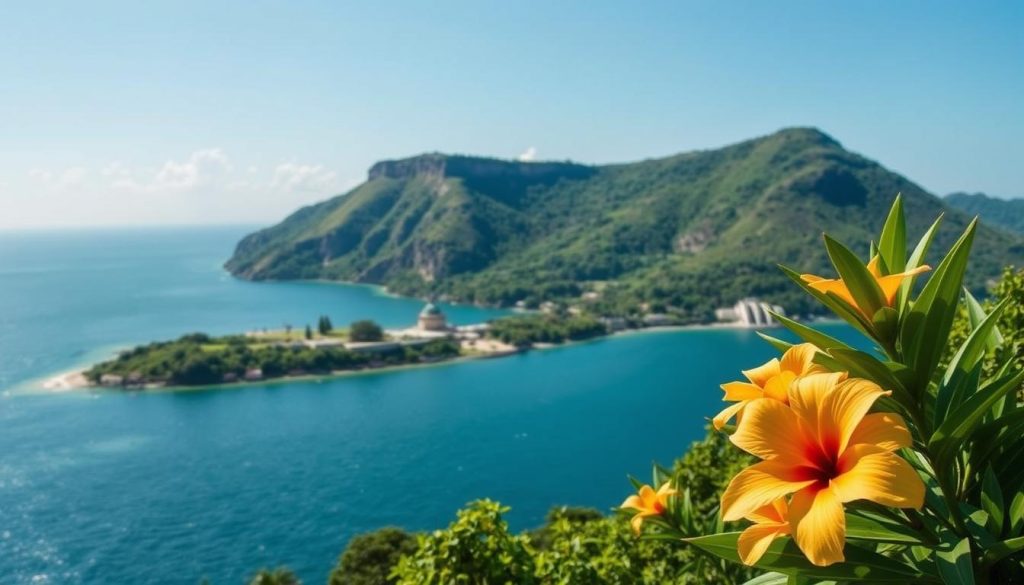
- Pacific War Memorial viewpoint
- Tail end of the island’s panoramic vista
- Malinta Tunnel entrance
- Japanese Garden of Peace
Plan your photos wisely. The golden hours, just after sunrise and before sunset, are best. They give your photos a soft, dramatic light. Use lenses that can capture both wide views and close-ups.
“Every photograph on Corregidor tells a story of courage and sacrifice” – Local Photography Guide
Keep your camera ready when hiking. The island’s trails offer great photo spots. From old war structures to greenery, there’s always something new. Wear comfy shoes and keep your gear safe from dust and water.
Here’s what you’ll need:
- Wide-angle lens for big views
- Macro lens for close-ups
- Tripod for steady shots
- Weather-sealed camera bag
Always be respectful of the memorials. Follow local rules when taking photos. Your pictures can tell Corregidor’s deep history.
Conclusion
Corregidor Island is more than a typical historical tour. It offers a deep dive into World War II history. Your visit will make history come alive.
Must-see spots include the Malinta Tunnel and the Pacific War Memorial. These places share stories of courage and sacrifice. They are perfect for anyone interested in history or the Philippines’ culture.
Corregidor is not just a place to visit; it’s a learning experience. It has military ruins and stunning views. Your trip will teach you about important world events.
Get ready for an adventure that’s different from usual tourist trips. Corregidor Island has history and beauty. Bring your curiosity and sense of adventure for an unforgettable journey.
The above is subject to change.
Check back often to TRAVEL.COM for the latest travel tips and deals.
Here are some Tours & Sightseeing suggestions that might pique your interests!
